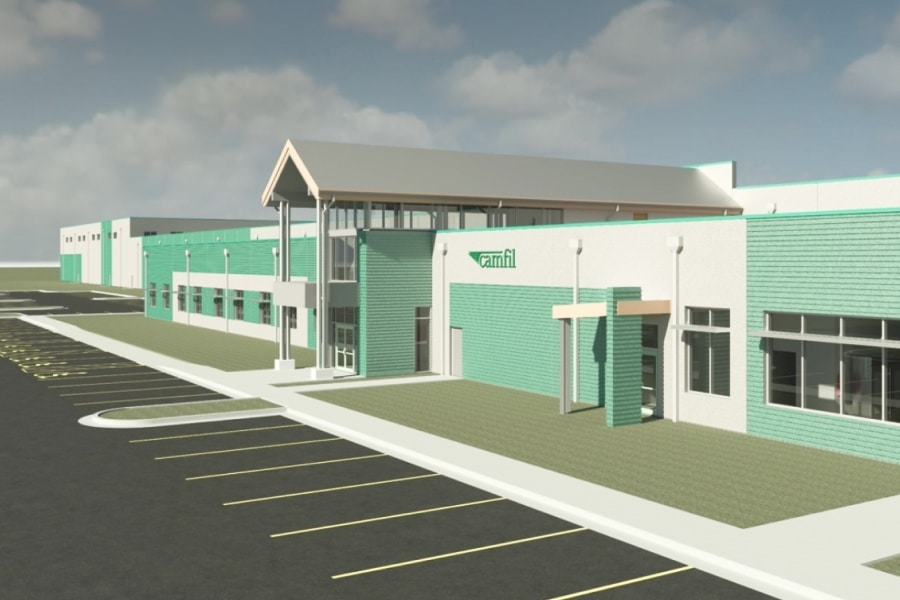For some people, the word “plastic” conjures up a world choking on waste, as oceans and rivers become clogged with discarded fishing nets, packaging and other trash.
Clearly, there is an environmental problem around such waste material. Things like the Great Pacific Garbage Patch and images of beaches covered with waste plastic have been a part of environmentalists’ pushback efforts for years.
Plastic waste is an issue that is now widely acknowledged and slowly being addressed through government and industry-led recycling initiatives, along with demand from retailers and consumers for more environmentally friendly plastics.
Yet just as plastic is many people’s environmental bête noire, the material still has its place, including in medical devices and lightweight packaging that is responsibly disposed of and recycled.
Key role
Plastics can also play an important role in construction. According to the British Plastics Federation (BPF), which represents a variety of companies that operate in the plastics sector, an estimated 19% of all plastics produced in the UK are used by the construction industry.
Buildings are rarely made entirely from plastic, although examples do exist, such as the three-bedroom home in Nova Scotia made from more than 600,000 plastic water bottles.
Others that have incorporated plastic include the Silver Shack in South Korea, made from translucent polycarbonate sheets fixed to a steel frame, and the Zig Zag house in the US, which features a polycarbonate “skin.”
One of the main plastics used in construction is PVC – polyvinyl chloride. It is found in applications like PVC-U window profiles, cables and roofing.
“PVC,” a spokesman for the BPF tells Built in a response to our questions about plastics in construction, “is very adaptable, which means it is also used in projects like creating stages for festival performances, inside wind turbine blades or solar-powered shade structures to generate green energy.”
PVC, along with polyethylene (PE), is also used in piping and conduit systems, which account for the biggest share of plastics in construction, around 35%. Cabling, rainwater goods, large diameter pipes for sewage and drainage, and potable water systems are usually made from PVC and PE.
Another material used in construction is expanded polystyrene (EPS). Being 98% air and 100% recyclable, the BPF argues EPS offers “a sustainable, lightweight, high-strength solution for applications like roof, floor and wall insulation, bridge and road widening schemes, and underground heating system support.”
Easy to cut and mold, EPS lends itself to complex shapes while keeping waste to a minimum. EPS blocks have helped train station platforms be installed in days rather than weeks, “reducing cost, waste and disruption to commuters,” the BPF notes.
Recycled plastic building materials
Designers, meanwhile, are mindful of what happens to a building when it passes its “sell-by date” or is likely to be refurbished, and to this end, construction is no stranger to recycling.
Dealing with waste building materials has been a growing activity for some time, either recycling for other uses or giving parts of a building a “passport” so it can be reused “as is” in another initiative.
Once plastic has come to the end of its useful life, it should ideally be collected and recycled into a feedstock material, which can be used to make other products. Sometimes this isn’t possible, so the likelihood increases that such material will end up in a landfill site or being burned in a waste-to-energy facility.
There are some pioneers, however, seeking to develop markets for those hard or impossible-to-recycle waste plastics. MacRebur, a manufacturer based in Lockerbie, Scotland, incorporates waste plastic that cannot be recycled into bitumen to create roads.
MacRebur worked on the resurfacing of a 900-meter (980-yard) stretch of the A709 in Dumfries & Galloway in Scotland, using 2.3 metric tons of waste plastic, equivalent to 184,000 500ml plastic bottles.
The benefits of using plastic in construction center around its lightweight characteristics and the fact that it lasts a long time; unless it is biodegradable, plastic doesn’t rot. Many PVC pipes installed more than 60 years ago, for instance, continue to function as well as ever, reducing the need to manufacture new products.
For the construction sector, this can be an enormous benefit, particularly in areas such as water and gas piping, roofing and insulation, and it fits the recycling agenda when a building is being dismantled.
Still, recycling is an important part of the picture. The BPF points to a number of recycling initiatives, including RecoVinyl and Recotrace, a data system to monitor plastic recycling and recycled plastics use, benefiting the construction sector. It notes the UK and Ireland collected and recycled a total of 143,428 metric tons of waste PVC in 2019, 86,057 metric tons of which were window profiles.
Fire safety
While the benefits of plastics in construction are apparent, there are issues around their viability, notably in the area of fire resistance. Tragedies like Grenfell have led many to question the degree to which it is used in insulation systems.
The Grenfell fire, which in June 2017 led to the deaths of 72 people and is still the subject of a public inquiry, was said to have been fueled by the presence of combustible plastic material – materials that passed regulatory safety checks at the time – sandwiched between thin metal panels on the exterior of the 68-meter-tall (223-feet-tall) West London tower block.
The fire led to legislation that saw similar combustible cladding being banned from use on new buildings over 18 meters (59 feet) tall. Of course, the question some will always ask is why use any sort of combustible material on high-rise – or indeed any other – homes in the first place?
While the presence of some plastics in building features such as cladding and some roofing products can be questioned, the material still has its place in construction.
With new methods of construction becoming more popular due to their cost-efficient practices and quality outcomes, the BPF believes plastics have a bright future.
A new era for plastic building materials?
It says: “The construction industry has a tendency towards traditional materials, tried and tested methods and products, but plastics offer opportunities for innovation.”
“Changes to the industry are now being accelerated through an increase in demand for housing coupled with new regulations which are intended to make the industry more energy efficient, manage waste, recycle and take lifecycle analysis into consideration.”
The plastics sector is looking to take advantage of a shift toward the delivery of intelligent buildings and modern methods of construction, moving building work away from muddy and weather-dependent sites and into factories.
The BPF argues that new materials and a range of polymeric composites and glass-reinforced plastic materials have implications for structures.
“One of the principal advantages of plastics are their ability to be designed to a wider range of uses. Their resistance to corrosion, light weight and strength make the potentiality of load-bearing structures as opposed to architectural features a possibility,” it adds.











